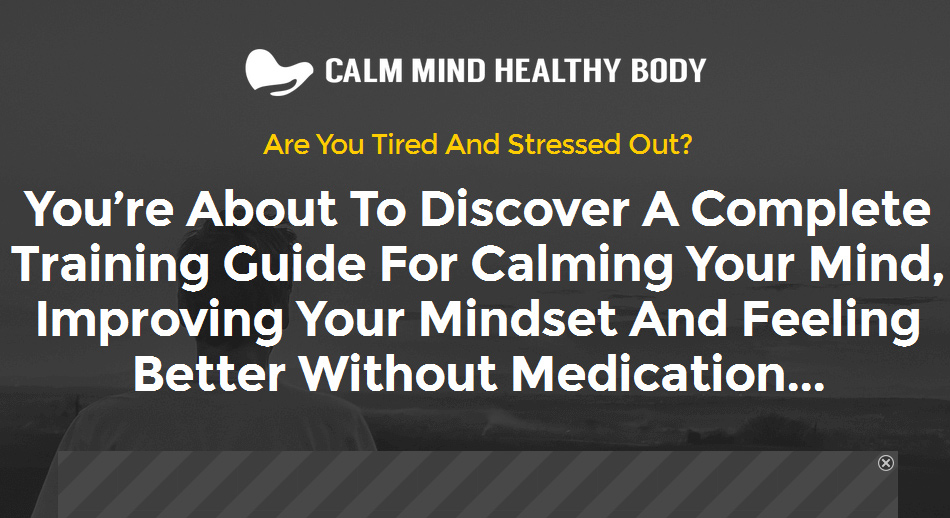Salespage Snapshot:

>>> Click Here To View Full Sales Page…
Table of Contents
Chapter 1: Time to Take Control . 3
It’s Your Perception That Matters . 4
Chapter 2: An Introduction to Meditation …. 6
Just What is Meditation? .. 6
The Varied Benefits of Meditation 7
An Introduction to the Different Types of Meditation ….. 9
Chapter 3: Introducing Meditation Into Your Life .. 13
A Simple Program to Get Started With … 13
Chapter 4: Becoming More Present 16
Meditation in Everything You Do 16
Being More Present .. 17
Chapter 5: Flow States – Tapping Into Your Innate, Ultimate Performance …. 20
How to Stop Being a Zombie . 21
What is a Flow State? 23
Flow States and the Human Brain . 24
The ‘Default Mode Network’ .. 25
Chapter 6: Shutting Out the Noise .. 27
Why We’re Wired and Tired . 27
A Morning Ritual . 30
Chapter 7: Cognitive Behavioral Therapy – For Controlling Your Own Thoughts .. 32
What is CBT? . 32
CBT Techniques Explained …. 34
Chapter 8: Using CBT to Change Your Life Forever . 37
Sleep Soundly .. 37
Overcome Anxiety . 38
Gratitude … 38
Entering Flow .. 39
Chapter 9: Conclusion … 40
Sample Content Preview
Chapter 2: An Introduction to Meditation
When we think of taking control of our minds and finding calm in a busy and hectic world, many of us will instantly think of meditation.
Meditation is an ancient practice that is used by billions of people around the world and that has been practiced for centuries. Now scientists and researchers are starting to decode it’s many benefits but nevertheless, it’s still very understood by a great number of people.
Let’s take a closer look at meditation, how it can help us and how you should get started.
Just What is Meditation?
Perhaps a good place to start is to answer the question: what is meditation?
While many people think of meditation as a way to ‘achieve enlightenment’, to recreate the effects of hallucinogenic drugs, or to practice various religions; the reality is that meditation is simply a form of practicing control over your thoughts. It can be all those things, but at its most basic, meditation means try to focus your thoughts or clear your mind, which is essentially the equivalent of training your attention.
So often our thoughts are reactive. We are constantly being distracted and taken from one experience to the next – whether due to television, to music or to something else entirely. But when you meditate, you will be actively controlling your thoughts. You will become introspective and you will start to reflect on the very nature of thought itself. And as you do, you’ll learn to remain in control of your thought processes so as to prevent yourself from becoming easily distracted, stressed, angry or otherwise experiencing inappropriate or unhelpful emotions.
This is a highly valuable form of training and one that’s particularly relevant in today’s fast-paced and constantly-connected world. Meditation can help us to conquer stress, to improve concentration in a range of tasks.
The Varied Benefits of Meditation
Studies show that meditation can help us to improve our mood, our concentration, our focus, our creativity and more. It has both immediate benefits by providing us with a break from the stress of our internal monolog and helping us to experience ‘theta brainwaves’ but it also has long term benefits as we start to learn to better control and understand our own thoughts and emotions.
Meditation has even been shown to boost our IQ! That’s right, it can actually make you smarter. And this also correlates with more connective tissue in the brain and a greater ability to utilize different areas of the brain at once for single tasks.
Fortunately, meditation is gradually starting to make its way into the mainstream. More and more ‘productivity’ and ‘lifestyle’ coaches are recommending its benefits and it forms an integral part of Cognitive Behavioural Therapy – which is currently the most popular form of clinical intervention for a whole host of psychological difficulties.
Still not convinced? Then I invite you to have a listen to Tim Ferriss’ podcasts. Tim Ferriss is the author of The Four Hour Workweek and is one of the most influential writers on the net when it comes to topics like fitness, self-improvement, productivity and happiness. His most recent project – the podcast – sees him interviewing a large number of different influential figures.
Those include Matt Mullenweg (creator of WordPress), Maria Popova (of Brain Pickings), Arnold Schwarzenegger and many, many more. One of the questions he’ll often ask them is what their morning routine looks like and if they have any other habits they consider important to their success.
What does Tim Ferriss note is the one thing that nearly all his interviewees have in common? They all meditate. So if you want to be one of the world’s most influential entrepreneurs, if you want to be spiritually enlightened or if you just want to be smarter then you need to start meditating!
But while meditation has benefits across the board, it’s worth noting that some forms of meditation appear to be more effective at promoting specific physiological benefits than others (according to a study from the National University of Singapore). If you want to get the best benefits from meditation, then you need to choose the right type to get started with.
Here’s what the study found when comparing Theravada and Vajrayana meditation…
Theravada Meditation
In the study from the National University of Singapore, it was found that Theravada meditation is more effective than Vajrayana (below) for promoting relaxation and calmness. Studies measured activity of the parasympathetic nervous system – the prime purpose of which is to promote calmness – while practitioners were deep in meditation.
Vajrayana Meditation
Those using Vajrayana meanwhile were found to activate their sympathetic nervous systems, which control the fight-or-flight response. In short, this would lead to elevated heartrate, focus and arousal. This is a particularly interesting finding, as conventionally we view meditation as a means to calm ourselves and to relax.
After the participants had engaged in their meditative practices, both groups were then asked to take cognitive tests and it was found that the Vajrayana group were able to boost their
performance considerably from a single session. The same boost in cognitive performance was not seen in those using Vajrayana meditation.
This demonstrates the broadness of the term ‘meditation’ and shows that different types of meditation have different specific advantages. In this scenario, you might decide to use Vajrayana meditation to psych yourself up for a competition or to prepare for an interview, then use Theravada meditation to calm down afterwards or to chill out before bed.
An Introduction to the Different Types of Meditation
As you can see then, the type of meditation you use is a very important factor in determining the outcome. Likewise, you will likely find that some forms of meditation are more accessible and enjoyable than others, depending on your own goals, your experience and your interests.
The question then becomes: where to start? Read on and we’ll look at some different types of meditation and some different terms. Bear in mind that you don’t have to stick rigidly to any one of these and actually you can create your own ‘kind’ of meditation by just setting your own goals. Nevertheless, any of these will provide you with a good starting point to do more of your own research and to start practicing the art of meditation.
Mindfulness: Mindfulness, also called ‘Vipassana’, is a type of meditation that comes from Buddhism. It’s also the form of meditation that’s perhaps most widely used in the Western world today – a good example being its use within CBT (this is something we’re going to come to in much more detail in subsequent chapters).
Essentially, the goal in Mindfulness is to be ‘aware’ and to be ‘present’ of your own thoughts and to reflect on them. This form of meditation doesn’t encourage you to try and empty your mind then, but rather the objective is simply to let your thoughts ‘drift by’ like clouds in the sky.
What this then allows you to do, is to become more aware of what thoughts you actually tend to have, thereby being better able to spot negative thought patterns etc. that might be causing problems. This type of meditation has also been shown to reduce anxiety, almost as effectively as anxiety-reducing drugs. Perhaps the biggest advantage of mindfulness though, is that it’s not
as challenging as trying to completely empty your mind of thoughts and thus provides a great starting point for those interested in learning.
Zazen: Zazen is a term that essentially means ‘seated meditation’ and is sometimes referred to by the modern Zen tradition as ‘just sitting’. This is an incredibly minimalist sort of meditation, which once again makes it ideal for those interested in getting started by feeling a little anxious to give it a go. The only instruction here is to sit with the correct posture, meaning that there’s no pressure to get anything ‘right’. The simple act of sitting completely still is almost sure to result in a calming effect and to gradually clear your mind, thus there is no need for complex instruction beyond ‘just sitting’.
While this is the core principle behind Zazen, it will sometimes be more complex than that. Often practitioners are given a paradoxical sentence, a story, a question or an element of Buddhist scripture to ‘muse on’. This method of meditation has also been adopted by a number of other religions – whereby believers are asked to think about lines from their respective religious scripts, or to think over scenes from their literature.
Other Details- 10 Articles (TXT)
- 1 Ebook (PDF), 41 Pages
- 7 Graphics (PNG)
- 1 Salespage (HTML)
- 10 Ecovers (PNG)
- 10 Promotional Ad Materials (Emails, Banners)
- Mindmap, Resource Report, Cheat Sheet, Social Media Images Pack, Legal Page, Sales Video
- Year Released/Circulated: 2016
- File Size: 90,172 KB
License Details:
[YES] Can be packaged
[YES] You Can Use This Product Yourself
[YES] Can be sold as it is not less than $7 price tag!
[YES] Can pass on the Resell Rights privilege to your customers.
[YES] Can Add This Product to a Membership Site or Bundled Within a Product Package as a Bonus.
[YES] Can be used to create audio/webinar/video products
[YES] Can Give Away The Product (NOT The Source Code Files) To Your Subscribers, Members or Customers as a Bonus or Gift.
[YES] Can change sales page and/or graphics
[YES] Can be added to paid membership sites
[YES] Can sell master resale rights
[NO] Add to a free membership sites
[NO] You can’t just pass away the product to anyone
[NO] Contents of the product can be edited, modified or altered.














